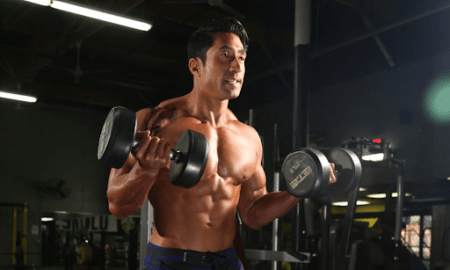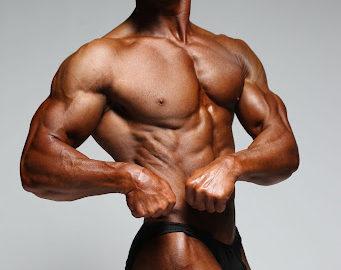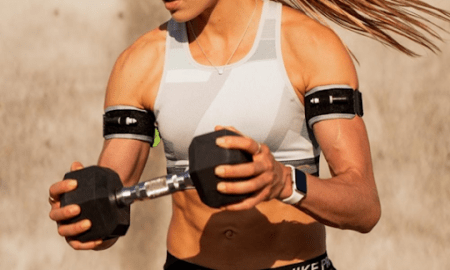Biceps. Everybody loves to build big biceps, and everybody loves to do curls. Ironically, many bodybuilders don’t know how to curl correctly. Curling isn’t as simple as it may appear. You have to do a lot of things right to activate the target muscle properly. If you don’t, you end up working your forearms and delts more than your biceps.
One of the most important factors is wrist position. Your wrists should remain locked and straight at all times. I first learned about the importance of keeping the wrists locked from Frank Zane’s mail-order courses back in the early ’70s. In fact, Zane said that he’d always had a hard time isolating his biceps when curling until Arnold Schwarzenegger told him to keep his wrists locked. Here’s why it’s so important.
You reach the top of any curl rep when your biceps contract, not when the bar or dumbbell hits your shoulder. If you keep your wrists locked straight and don’t move your elbows up, the bar should stop several inches away from your shoulders, at the nine or 10 o’clock position for most men, because your biceps will get in the way and prevent further movement. If you let your wrists bend, though, the weight can fall into your shoulders, and your biceps won’t contract fully, if at all.
The elbow position is also of paramount importance for making the biceps work hard. Hold your elbows against your body and don’t let them move up, forward, out from your body or back.
Try it. Stand up as if you were holding a barbell at arm’s length. Squeeze your elbows into your sides so they can’t move. Now curl your hands up as far as they’ll go. You’ll notice that if you don’t let your elbows move, your hands come up only about halfway before the biceps contract at roughly nine or 10 o’clock, depending on the size of your arms. The bigger your arms, the shorter the distance you’ll be able to get the bar up. Your upper arms should remain motionless when you curl; only your forearms should move. At least that’s the way to perform a truly strict curl. Any upper-arm movement at all constitutes cheating, even if you don’t swing or heave the weight up.
To increase the intensity on your biceps, start your sets by curling in the elbows-into-the-body, stationary position. Proceed through your reps until you can no longer raise the weight. Then switch to what people usually mean when they talk about strict curls’that is, letting your elbows move a little’and go to failure again. At that point switch to cheat curls and go to failure again. When you perform your curls that way, you work your biceps into the ground.
Shoulder position is also very important during a curl. You should keep your shoulders down and back at all times. If you shrug your shoulders as you curl, your delts and traps assist in lifting the bar, taking work away from your biceps.
I picked up another useful curling tip from Lee Haney in 1984, when I attended a seminar he gave at the old Gold’s Gym in Scarborough, Ontario, several months before he won his first Mr. Olympia title. According to Lee, you should squeeze hard at the top of the movement and not rest. Most novices and intermediates do their curls backward, he said. They use a lot of effort to get the bar moving up and past the sticking point, and then they relax at the top, using that position as a resting spot. In addition, they usually let their wrists bend, letting the bar fall into their shoulders. Lee’s solution was to reverse the procedure. Instead of resting at the top, you squeeze and tense the biceps hard so they contract. Then you rest at the bottom of the rep, when your arms are straight.
To explain the idea more clearly, Lee said to think of the arc that the bar makes as it travels from midthigh to shoulder level and compare it to the speedometer of your car. The bottom is 0, and the top position is 60. As the bar leaves your thighs and your arms begin to bend, start squeezing and tensing your biceps to make them contract. The bar should pick up speed as it approaches the top, and when you get there, you should be squeezing the hell out of your biceps. Then slowly return to the starting position and pause at the bottom.
While Haney likes to use a short rest at the bottom, Sergio Oliva does his curls without ever letting the bar stop moving; that is, there’s no deliberate pause at either the top or bottom of the rep. That puts constant tension on the biceps and can be very intense. For variety you might want to curl like that every so often. You’ll have to use less weight’but what a pump you’ll get.
Speaking of constant tension, Vince Gironda was a staunch advocate of drag curls. They’re just what the name implies, as you drag the bar along your body to a point below your chest. The bar never leaves your body. When it’s halfway up’at about the nine o’clock position, you’ve reached the top of the rep. At that point press your arms into your sides, arch your chest, drop your chest and pause for a count of two while you squeeze and contract your biceps. Then slowly lower under tension.
Another variation is 21s, which really blast the biceps. Vince Gironda advocated these for more than 40 years, and former Mr. Universe Charles Glass said that they’re his favorite way to train biceps. One thing’s certain: They are painful. The name 21s means 21 reps. Here’s how to do them: Curl a weight from the bottom for seven half-reps, and then, without resting, do another seven half-reps from the top. Again without resting, finish with seven full reps. Yeow! I can feel it just by writing about it.
These tips are just the tip of the iceberg’or top of the biceps peak’for big arms. I’ll have a few more biceps-building tips next month and then move on to triceps. IM




















You must be logged in to post a comment Login